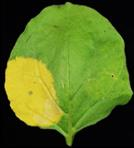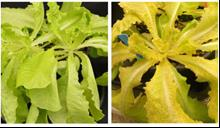CSIC and the Center for Research in Agricultural Genomics have developed a biotechnological method
for the biofortification in carotenoids and other phytonutrients of green tissues. The method is based
on the controlled induction of chromoplasts. The mechanism could be applied to the development of
novel functional foods or bio factories for a variety of industries.
Industrial partners are being sought to collaborate through a patent license agreement.
Management of nutritional benefits in crops
Lettuce inoculated with viral vector and control at 12 days (F. Houhou y J.A. Daròs) Tobacco leaf 16 days after being agroinfiltrated in the lower left with constructs to produce chromoplasts Controlling chromoplast differentiation has been proposed as a very promising strategy to improve the nutritional and health benefits of crops and for other biotechnological efforts, due to its unique ability to accumulate large amounts of carotenoids (pro-vitamin A) and other antioxidants and dietary nutrients such as tocopherols (vitamin E).
The present work shows for the first time that the supply of a sufficiently large quantity of phytoene in chlorophyll-containing plastids (chloroplasts) leads to their artificial or synthetic transformation into carotenoid and tocopherol-accumulating plastids (chromoplasts) in green tissues.
The method proposes agroinfiltration or any alternative method such as the use of viral vectors for the supply of phytoene to the chloroplasts of plants or crops once their photosynthetic activity is dispensable (for example, just before harvest).
Main innovations and advantages
▪ Technology applicable to the nutritional improvement (biofortification)of cell cultures, leafy vegetables, green fruits, crops for humanconsumption and forage crops.
▪ Better use of the potential of crops. The method would allow thecreation of bio factory plants to obtain products of interest to thecosmetic, pharmaceutical and food industries, such as carotenoids andtocopherols (natural pigments, antioxidants and essentialphytonutrients).
▪ Compatible with a localized use in the plant (for example, the leavesthat are not commercialized as biofactories can be used and the fruits,seeds, tubers and roots can be left intact).
▪ Method free of chemical pollutants or substances harmful to theenvironment, such as nitrogenous fertilizers or antibiotics.







